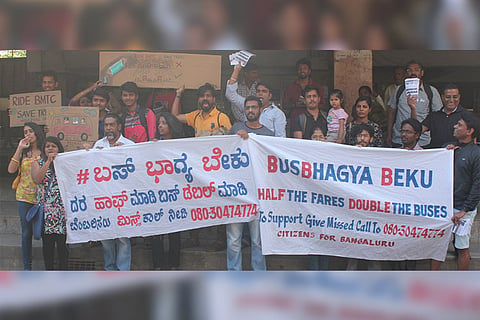

"Half the Fares and Double the Fleet," That is the demand of a growing citizen-led initiative in Bengaluru wanting affordable public transport in the city.
Two city groups, Citizens for Bengaluru (CfB) and Bengaluru Bus Prayanikara Vedike (BBPV), have started the #BusBhagyaBeku initiative after meeting various organisations and carrying out commuter surveys in different parts of the city.
"With respect to traffic, Bengaluru is in deep trouble at present. No number of flyovers or fancy projects will prevent traffic congestion. The solution is an effective public transport," says Srinivas Alavilli of CfB, a group that came together last year to protest against the proposed steel flyover in the city.
The problem however is that bus fares in Bengaluru are extremely high compared to other cities in the country. There are also not enough buses plying on the roads to cater to the city's growing population.
It also doesn't help that the existing connectivity is very low, especially to outer areas of the city.
"Research shows that one bus can replace 50 cars and 200 bikes. And one bus carries around 1,000 passengers in a day," Srinivas says. "If we have more buses on the roads, the number of private vehicles will come down. So will traffic congestion and pollution."
For their survey, the organisation spoke to many garment factory workers, some of whom make a meagre Rs 7,000 per month.
"How can they afford a bus pass costing Rs 1050?" he asks.
Many choose to walk, or get down a few stops before their destination in order to save on fare and walk the rest of the distance.
Those who don't have the option of walking, prefer to commute by tempos that, though cheaper, are unsafe. After all, the tempo charges Rs 10 whereas they'll have to pay Rs 30 on the bus.
The population rise in the city has been exponential in the last decade; Srinivas describes it as an "entire Chennai added to Bengaluru". So has the rise in the number of vehicles.
"However, in the last three years no new buses have been added to the BMTC's existing fleet. Nor have the ones that are not in working condition anymore been replaced," he states.
"Today, it is cheaper to use a bike in the city."
So what stops the BMTC then from introducing more buses on the city's roads and easing what is one of Bengaluru's largest civic issues?
It is because of a lack of any form of support from the government, says Vinay Sreenivasa of BBPV. BBPV is a collective of several organisations and individuals that was formed in 2013 after a bus fare hike by the state government. It has constantly been seeking a reduction in fares along with demanding safety of women and gender minorities in buses and terminals.
Vinay explains that the BMTC does not get any tax breaks - such as on diesel tax, road tax or motor vehicle tax - from the state government, like several other states do.
In Chennai, the salaries of the employees of the Metropolitan Transport Corporation (MTC) is taken care of by the state government. BMTC, on the other hand, gets no such help.
And this is what has made BMTC "the most expensive public transport in the country after seven fare hikes in the past three years making it unaffordable and a luxury mode of travel for daily wage earners," according to the #BusBhagyaBeku initiative.
"After a 2014 hike in fares, there was an 8% drop in the number of people using buses. Some chose to walk, many moved to two-wheelers," Vinay says.
"Bus is a public transport, it is a service. It cannot be seen from a revenue perspective. It has to been treated just like healthcare or education issues," he adds.
“While other states help their Road Transport Corporations (RTCs), in Karnataka, the state government seems to be only interested in investing crores in the metro project. When the Phase 1 of the Metro was under construction, it was said that an estimated 10 lakh people would use it every day. Currently only 5 lakh people use it. It is being said that once Phase 2 is completed, around 16 lakh commuters will use the metro daily. BMTC carries 50 lakh people daily now. Then what is preventing the government from investing in it?" Vinay asks.
“Bengaluru is at its breaking point. There are traffic issues, pollution and rampant chopping of trees. If the congestion comes down, you won’t need a new flyover or new roads. Buses can save the city," he says.
#BusBhagyaBeku is urging citizens to take the bus to Shanthinagar TTMC on Saturday, March 4, by 11 am as an expression of support to the right to accessible and affordable public transport. You can also support by giving a missed call to 08030474774.
For more information go to Bus Bhagya Beku - Bus Yatra to Shanti nagar Facebook page.